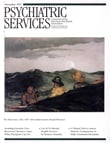Effectiveness of a continuum of care using brief and partial hospitalization for agitated dementia patients
Abstract
OBJECTIVE: A behavioral intensive care unit was originally designed as a 21-day inpatient program for treating agitation among demented patients, one of the most common behavioral disorders in this group. Due to the need to dramatically reduce length of stay and create alternative care environments, the original model was modified into an integrated continuum of care blending inpatient and outpatient care and partial hospitalization that reduced hospitalization from 21 to an average of seven days. This quasiexperimental study compared the effectiveness of the inpatient and continuum-of-care programs and conducted cost analyses. METHODS: Subjects were inpatients diagnosed with both dementia and agitation. Outcomes of 68 patients treated in the inpatient program were compared with those of 110 patients treated in the continuum of care. The primary outcome measure was patients' score on the Cohen-Mansfield Agitation Inventory, which provides a total agitation score and scores on three factors describing agitated behavior--physically aggressive behavior, verbally aggressive behavior, and nonaggressive behavior. RESULTS: A statistically significant reduction in agitation was found for patients treated in both programs, with no significant difference in outcome between programs. Patients in both programs showed significant improvements in physical aggression, verbal aggression, and nonaggressive behavior. The cost-effectiveness analysis revealed clear advantages for the continuum-of-care program, especially in the area of aggressive behaviors. CONCLUSIONS: The data suggest that the restructured program is an effective and economically feasible intervention.



